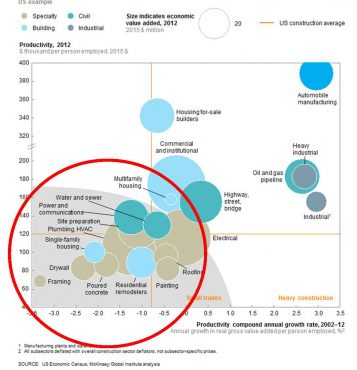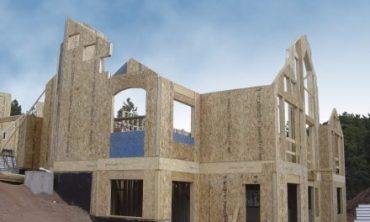
John Bleasby
Digging into construction productivity issues (Part One)
Canadian ContractorThe McKinsey Global report builds a foundation for much discussion
The McKinsey Global Institute report on the state of productivity in the construction industry published on the internet in February 2017 is 168 pages long and studies everything from residential construction to mega projects around the world. The bottom line: on a global basis, over the past 20 years construction in Canada has lagged in terms of productivity and income gains versus most other industries, despite being one of the better performing countries surveyed. Certain elements directly related to residential construction are the furthest behind.
It’s a massive report, however digging deep into the pages themselves reveals a number of issues and possible solutions to this lag that are extremely relevant to the residential construction industry. It’s a blueprint of what forward-thinking contractors and renovators need to consider for the future.

Note how most of the building trades fall in the lowest quadrant of this efficiency-gain chart…’framing’ almost being the worst in efficiency gains!
Are you an early adopter or a late follower?
Innovation in materials and processes that can improve productivity in construction are out there, but many are slow to adopt them. Such reluctance is not unique to construction. For example, the oil industry, Canada’s largest single GDP contributor, has been struggling with safe crude oil transportation for a long time. Meanwhile, innovations in the safe transport of crude by rail that would virtually eliminate the risk of combustion and environmental leakage through leakage are largely ignored by the oil giants. Why? Answer: it’s easy to stay the same if no one is pushing.
McKinsey suggests many firms benefit from a system that has in many cases encourages low-ball bidding followed by change orders or costly customizations after the fact. Such behavior can boost margins during a contract but do little to encourage productivity gains, which in fact could deliver the margin improvements contractors seek.
The argument for change, or not
Make no mistake; there will always be a place for doing things the same way. Residential construction and renovation is very much a bespoke, customized industry. It’s not like producing cars on an assembly line. Labour and materials need to be transported to the site, wherever that may be. Factories, on the other hand, can be built where labor is available, and cookie-cutter methods used in production. Therefore, not every aspect of residential construction is an easy target for change, at least not on the site. However, that doesn’t mean productivity improvements can’t be made in other areas of the operation that mimic other progressive industries.
Why productivity matters
The McKinsey reports puts it very succinctly. “An increase [in productivity] means that higher value can be provided to customers with the same or fewer resources, which translates into a desirable mix of higher-quality structures at lower cost for owners, higher profitability for contractors, and higher wages for workers.”
Not everything is within a contractor’s direct control
The report analyzes dozens of countries in terms of days required to receive all necessary permitting prior to construction. Canada did not fare well, ranking between 200 and 250 days. Only a handful of developing countries were ranked slower, like Russia, Bolivia and Pakistan. In comparison, the USA was less than 100 days. As an individual contractor, you can’t control that. However, as a member of your building association, you can lobby for more streamlined, transparent approval processes and less complex regulation. Likewise, approving new structural materials through standardised building codes, in line with other leading countries, would encourage further innovation and faster building completion times.
What you can control; start with the labor force of the future
The shortage of skilled trade workers in construction versus anticipated increases in demand over the next 10 or 15 years is well-documented. There is a continued effort from government, school boards and industry to encourage a new generation of men and women to consider a career in the trades rather than white collar pursuits. However, to be successful, wages and working conditions must be competitive. That means labor costs, safety, and reduced physicality of the work itself all need to be constantly improved. Adopting new building methods and improved procurement and site management procedures can contribute to this end result.

SIPs and CLTs work as well towards improving on-site efficiency and productivity as they do in multi-unit developments
Adopting Design-Build as a business model
McKinsey talks of “rewiring the contractual framework” to establish “a single source of truth.” In the language of residential contractors and renovators, this would suggest, for example, evolving to a design-build business model, almost at any level of the project. The advantages of this business model have been discussed by Canadian Contractor several times this year, both on-line and in print (March/April print edition, page 16-17). A single source for design, engineering and construction means projects proceed with a known and controllable budget, less likelihood for misunderstandings that risk contractual disputes, and a clearer vision for the client.
Rethinking the design and engineering processes themselves
The scaling of mega-project processes down to the residential industry is already a realizable objective. As McKinsey puts it, “The biggest impact on productivity would come from moving toward thinking about construction as a production system… encouraging off-site manufacture, minimizing on-site construction… assembling panels in factories and then finishing units onsite.”
The future is now!
For example, factory assembled components like SIPs (Structural Insulated Panels) and CLTs (Cross Laminated Timber) reduce the amount of labor hours required on a distant site, waste material (time spent dealing with waste is time lost to production) and human error. At the same time, product quality and consistency can be improved since inspections can take place under controlled conditions before reaching the site. It’s not dream technology. This type of residential construction is now taking place on all sizes of projects in other parts of the world. Furthermore, “repeatable designs” don’t have to be boring! The productivity gains from prefabricated components can in fact include a large range of options using perhaps a 3-D visualizer or cloud-based technology.
Here is where the issues of labor force requirements, career expectations of a generation raised with technology, and the continual desire to improve margins begin to converge.
Part Two: How your corporate procedures can contribute to improved productivity
In the meantime, give us your feedback!
Follow John on Instagram and on Twitter for notifications about our newest posts
Subscribe to our weekly on-line Newsletter for FREE!!!!

Advertisement
Print this page


Addressing construction productivity challenges is paramount for the industry’s growth and success. Exploring these issues can lead to innovative solutions, ultimately benefiting both construction professionals and clients.